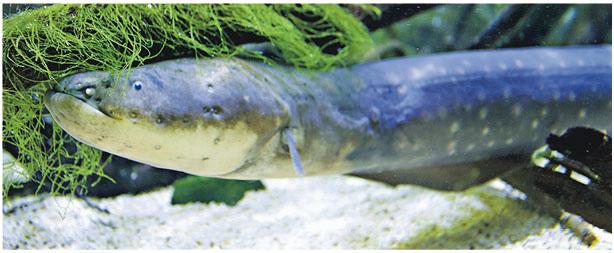Animal:The electric eel —— Hidden power of the Amazon
【明報專訊】Natural wonders are abundant in the lands of the Amazon, and its waters too. The electric eel (電鰻) found in the Amazon and Orinoco River basins of South America is probably one of the most awesome water creatures you may find.
Text and photos: Ocean Park Hong Kong
Although snake-like and called an eel, the electric eel belongs to the family of knifefish, more closely related to catfish (鯰魚) and carp (鯉魚) ! The electric eel breathes directly from the air, instead of under water. As it lives near the muddy river bottom where the oxygen level is low, it comes to surface periodically from its swampy dwelling to breathe.
Aquatic batteries
The dark green and greyish body of the electric eel is mostly made up of specialised cells called electrocytes (發電細胞) which store power like tiny batteries. These ''battery'' cells are found in its two main electrical organs, namely the Hunter's organ, and the Sach's organ. These two organs alone comprise 80% of its body. The fish's vital organs make up the remaining 20%, found in the front part of its body. With its compact ''battery'' cells, the electric eel can discharge electricity up to 600 volts, which is almost three times what a power socket in Hong Kong supplies (220 volts)! Despite its poor eyesight, the electric eel can send out weak electric pulses of 10 volts or below to navigate and search for prey in murky waters. The pulses are also useful for communicating with other electric eels, which is particularly important during the breeding season.
High-power attack
Extraordinary, isn't it? Wait, there's more to this remarkable creature! At 2.5m long and weighing almost 20kg, the electric eel is a fearsome predator that is more active at night. It feeds on fishes, crustaceans (甲殼類動物), insects, reptiles, birds and mammals. When prey is suspected nearby, the electric eel will first send out two rapid electric pulses which cause the potential prey to twitch (痙攣) involuntarily. With the prey's presence and location locked in, the eel quickly emits a series of high-voltage pulses which paralyses the prey. All this takes place so fast that our human eyes can hardly see how it happens!
Amazing creature
You must have a question in mind by now – how does the electric eel protect itself from its own electric shocks? The answer is simple. It has thick, slimy, scaleless skin which acts as a protective layer.
Isn't nature amazing? In order to ensure a healthy ecosystem for the electric eel and other incredible fishes, we should protect our freshwater sources such as streams, rivers and lakes.
[Smarties' Power English 第271期]





